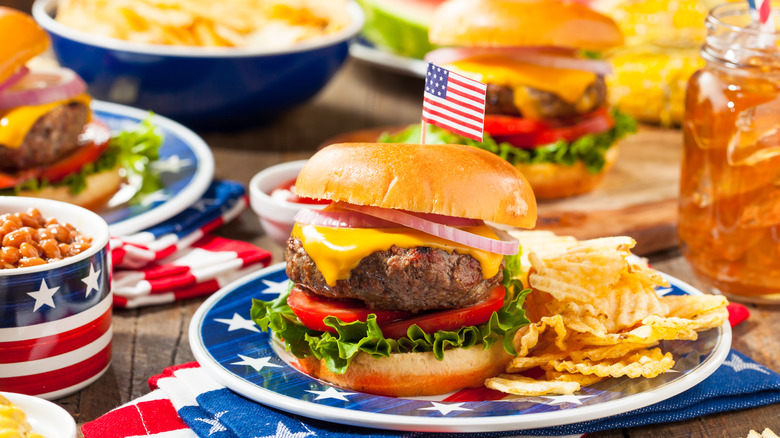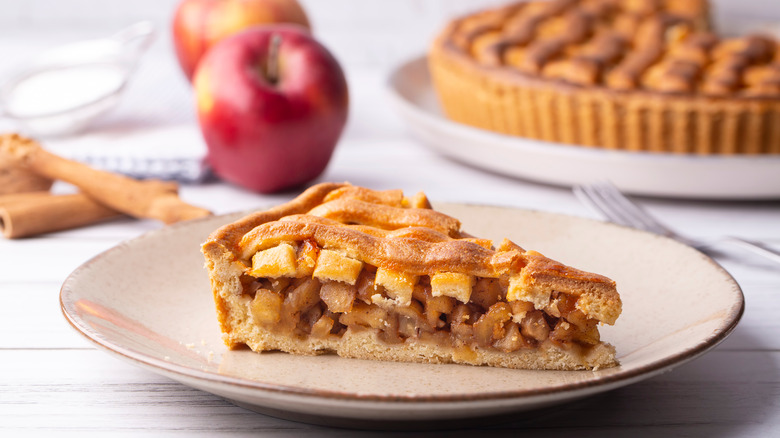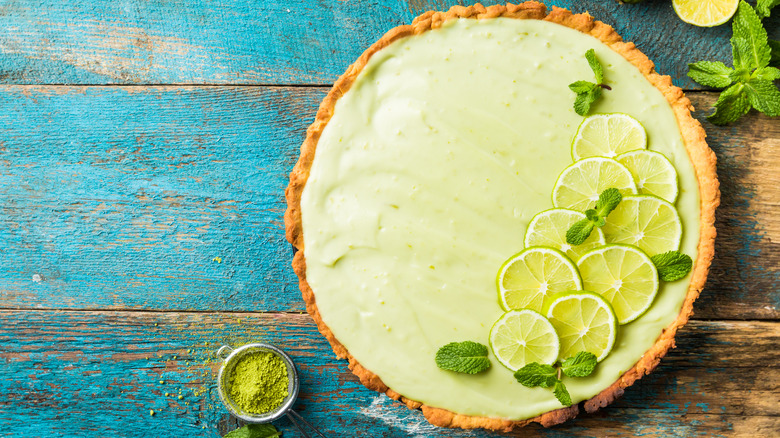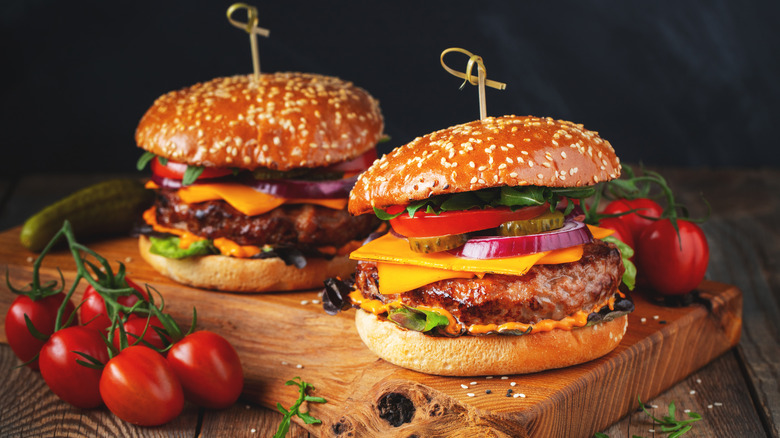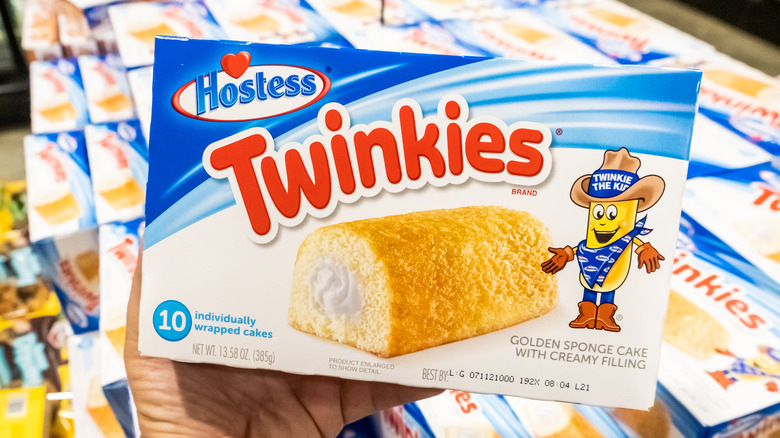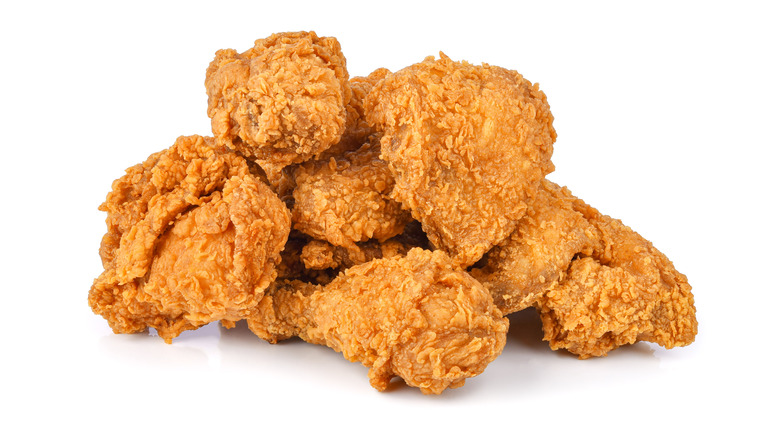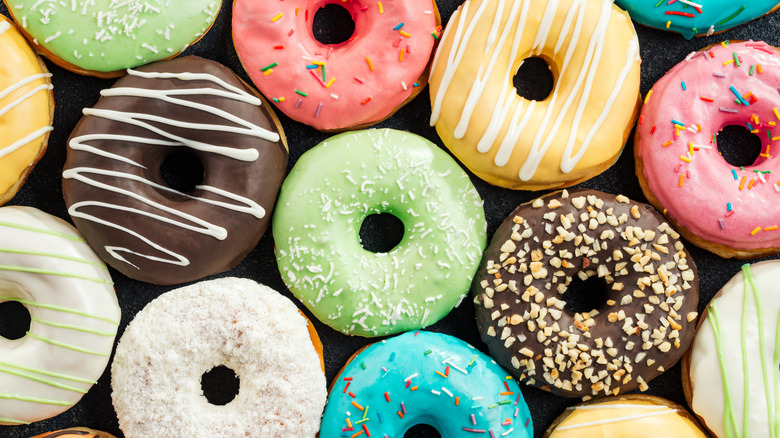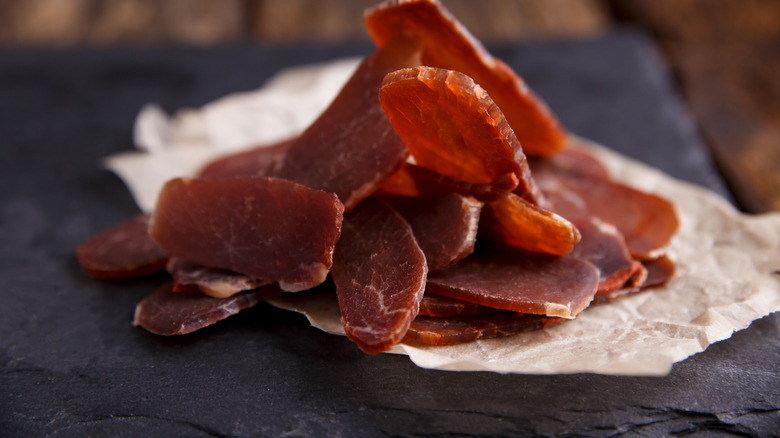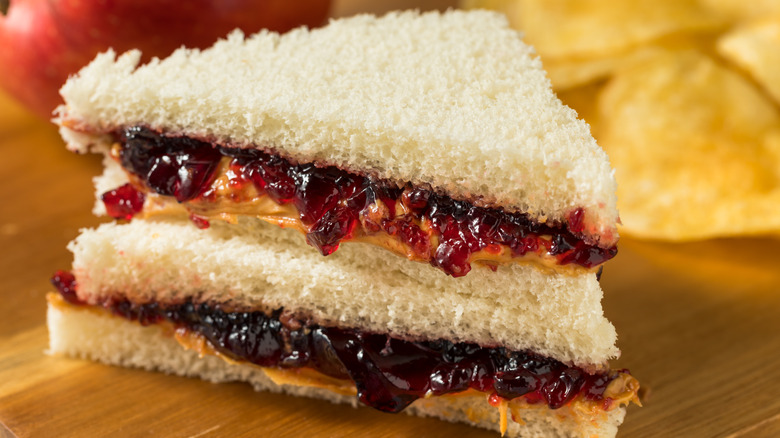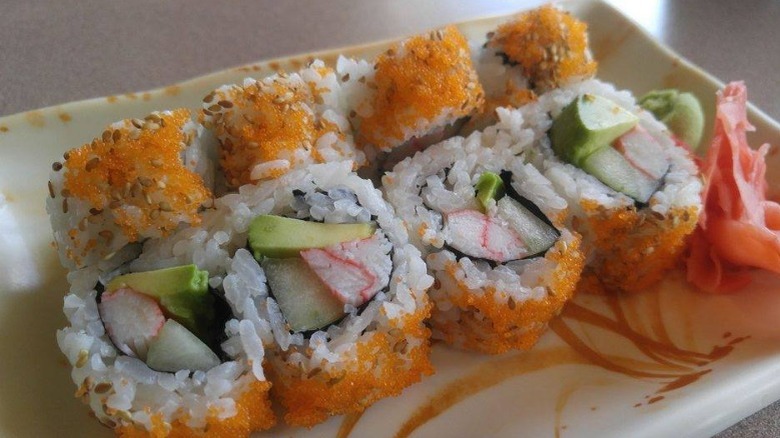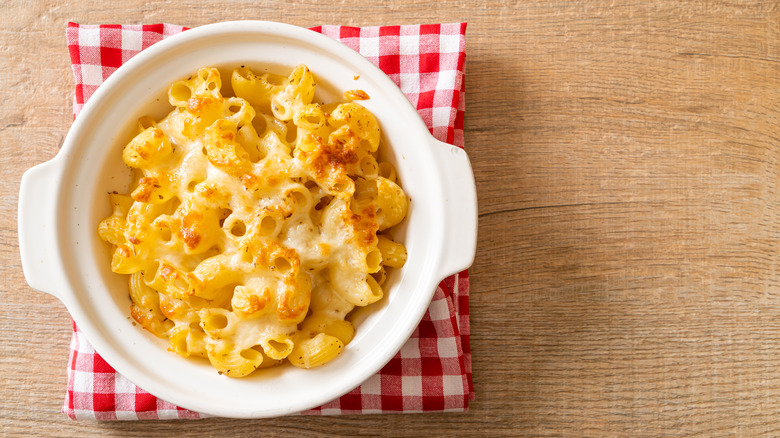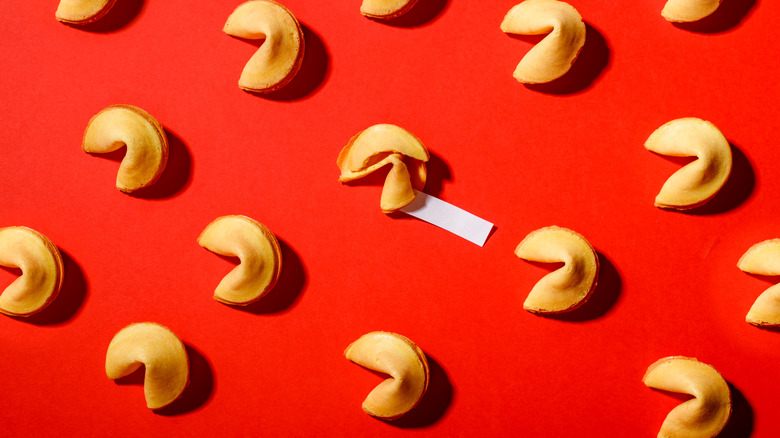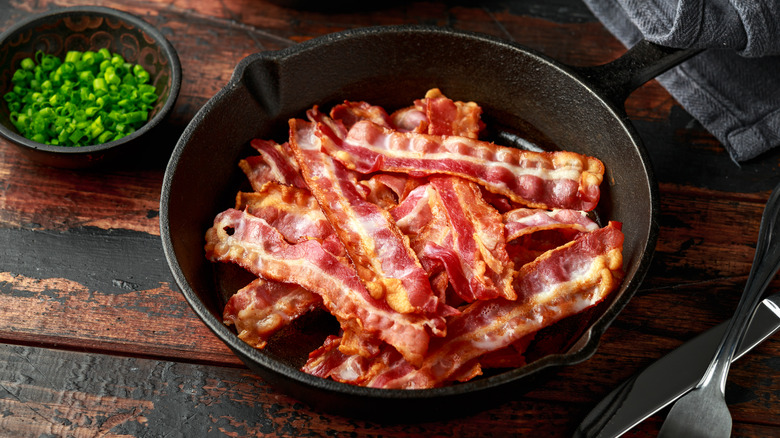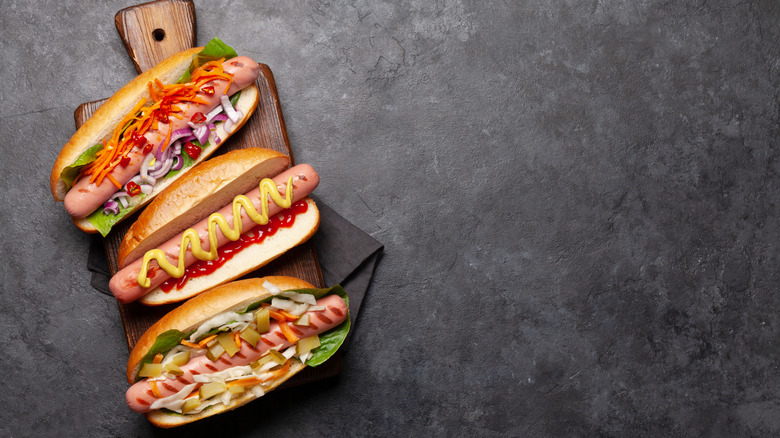The Real Origins Of American Foods
Genuine American cuisine is a glorious mishmash of different cultures, styles, and influences that vary from one region to another. Something as simple as barbecue, for example, can change dramatically from state to state. If you bop around the Northeastern states, you will encounter several different takes on clam chowder. And the "classic" ballpark-style hot dog is but one of countless versions of a hot dog that you will find across the country. Americans also have a tender fondness for specific dishes, especially when they're traveling abroad, and can extol the virtues of their particular state's best-known dish.
Every red-blooded American can rattle off a list of specialties supposedly from the United States, ranging from apple pie to good old-fashioned hamburgers, but the origins of some of the most popular American foods are actually a little bit more complex. Some are downright surprising or even counterintuitive. So read on if you think that you know everything there is to know about your favorite homegrown American dishes.
Apple pie
When it comes to fall flavors, the only one that can give pumpkin spice a run for its money in the United States is apple pie. That said, the origins of this tantalizing autumnal dessert are far from all-American. In fact, the expression might as well be "as British as apple pie" According to Today I Found Out, it's believed that apple pie originated in 1381 in England. However, it's a distant cry from the flaky-crusted sweet treat we love today. Back then, pie pastry was rock-hard and inedible, and apple pies conspicuously lacked sugar.
It was a pastry makeover that transformed this stodgy medieval pie into a modern-day American classic. According to The John Hopkins Newsletter, enterprising American chefs started making the crust an integral part of the pie rather than just a vessel to serve it in. The Dutch contributed their pastry techniques, sugar was added to the apple mixture, and a new and improved pie was born.
Key lime pie
Key lime might be the official state pie of Florida, but there have been rumblings that it actually has downright Yankee roots. According to Food and Wine, "BraveTart: Iconic American Desserts" author Stella Parks claimed that it is entirely feasible that the New York City-based Borden dairy created Key lime pie as a way to boost sweetened condensed milk sales. Understandably, this theory about Key lime pie did not go over well with Floridians.
Whether or not Key lime pie originated up North, its tart, tangy, and tropical flavor is full Key West. Now, if you happen to be craving the dessert right this instant but do not live in the Sunshine State, you do not have to book a last-minute flight. You can enjoy a perfect Key lime pie right at home with this simple and authentic recipe that will bring you true citrusy, creamy, graham-cracker nirvana.
Hamburgers
Hamburgers have an exceptionally unique history, starting way way back in the cradle of civilization. Our Mesopotamian ancestors first domesticated cattle, and it was only a hop, skip, and a jump in human culinary evolution before we started chopping up meat and forming patties with it. The more modern conception of hamburgers came from the identically named city of Hamburg, Germany, and German immigrants who brought Salisbury and chopped steaks to the salivating American palate, per History.
The second and equally important part of hamburger history revolves around the American fast food boom of the last century. Per Smithsonian Magazine, when White Castle pioneered its efficient model of mass grilling square beef patties, it kicked off a revolution. Suddenly you could get your hamburger fix in a flash with consistently good and predictable results. Hamburgers aren't just for the common folk either: Apparently, a good ol' burger is one of Queen Elizabeth's go-to American dishes.
Twinkies
There are plenty of myths swirling around America's favorite yellow cake with thick vanilla filling, including that they have an evergreen shelf life. Per NPR, the reality is that these tasty treats will expire on you in less than a month, but Twinkies are still hardy little snacks with the ideal cake to filling ratio. The name also comes from an utterly unlikely and delightful place: As a company rep told Today, Twinkies inventor Jimmy Dewar landed on the moniker after seeing an ad for Twinkle Toe Shoes.
Per The New York Times, Twinkies were originally injected with a banana-flavored filling, not vanilla. As with a few other beloved items on our list, the Second World War changed Twinkies forever thanks to a banana ration that forced producers to use vanilla instead. Although you'll occasionally find a peppermint or pumpkin spice Twinkie on the market, the traditional golden yellow cake with its generous cylinder of vanilla filling is by far the most satisfying and popular combination out there.
Fried chicken
Fried chicken's origins are complicated and controversial. According to the BBC, fried chicken combines Scottish frying techniques and West and Central African spices and traditions, thanks to Scottish immigrants and the culinary talents of enslaved people who elevated the dish and made it an American icon. Gastropod points out that enslaved people had their own frying techniques before being kidnapped and forced into the Transatlantic slave trade. Unfortunately, as with many early American foods, the contributions of Black Americans are often underplayed, ignored, or overshadowed.
What we do know is that most of the enslaved people who lived in the Southern part of the United States came from what's now modern-day Gambia, Mali, Senegal, Congo, Angola, Gabon, and the DRC, per History. Many of these people were forced to work in plantation kitchens and used culinary influences from their homelands to hone and perfect dishes. Whether the Scottish or enslaved Africans brought the concept of frying chicken to the United States might be up for debate, but there's no question who made it what it is today.
Donuts
As it turns out, tossing bits of dough into hot oil is as old as time; according to Smithsonian Magazine, donuts routinely show up at archeological dig sites. The modern version that we know and love today apparently came from an enterprising mom named Elizabeth Gregory. Evidently, Gregory's inventive snack for her seafaring son came in the form of fried dough with nuts in the middle of it, hence the name. Her son claimed to be the one who came up with cutting a hole in the center of the creation to make it easier to eat. Whatever the case, the earliest modern donuts were pretty basic by today's standards, with just a sprinkle of sweet spice and some citrus.
In 1920, Russian immigrant Adolph Levitt created the first industrial donut-making machine, churning out hot and fresh donuts to hungry New Yorkers and taking the classic dessert commercial. Per Time, legend has it that after actor Mae Murray dropped a donut in a cup of java on accident, things really kicked into high gear for the breakfast pastry. Today, donuts are almost universally loved and available just about anywhere.
Jerky
Those unassuming plastic-wrapped servings of jerky that you can find at any 7-11 have a very rich history dating back to at least ancient Egypt, and likely before. According to the USDA, our ancestors used jerky as a way to preserve meat, and virtually every culture all over the world had its own version. For example, Native North and South American tribes, like the Incas, specialized in jerky-making to prolong the fruits of the hunt. However, Food Preserving goes a step further, crediting jerky as the oldest known way to preserve food and speculating that the methodology might even date back to our prehistoric Cro-Magnon relatives.
Although it is an undeniably delicious treat that gives you a serious protein boost, jerky is also full of sodium and does have a health-related dark downside. Still, if you can stop yourself from scarfing down the entire package at once, jerky can be an excellent, cost-effective, sometimes snack.
Peanut butter and jelly
Peanut butter and jelly might be one of the most patriotic foods on our list because although it dates back to the turn of the last century, World War II veterans are the folks who made it a household name and a lunchbox staple. According to Reader's Digest, in 1901, Julia Davis Chandler dreamt up the combination for Boston Cooking School magazine. Although the combo might have caught on with the ladies who lunched and played bridge, it was still far from mainstream until the U.S. military decided to make PB&J sandwiches part of its rations, per National Peanut Board.
According to AZ Central, the success of the peanut butter and jelly sandwich hinged on three key things: sliced bread, grape jelly, and protein-rich, newly affordable peanut butter. Add in a World War with homesick soldiers, and you have yourself an iconic food item. The American fixation with PB&J isn't shared by the rest of the world, though, as many non-Americans find it to be a rather wonky food. Their loss.
California roll
There's plenty to debate about regarding the California roll's origins. According to Encyclopedia Britannica, Ichiro Mashita dreamt up the roll in Los Angeles, creating the fresh avocado and crab concoction and flipping the traditional seaweed wrapper inside the rice. On the other hand, as Vancouver Magazine notes, there's evidence that the California roll isn't American at all, but Vancouver-born.
In this version of the fresh, modern classic's origin story, Vancouver chef Hidekazu Tojo developed the roll to appeal to Western tastes, flip-flopping the seaweed wrapper and the rice and coating the whole creation in sesame seeds. Tojo told Insider that the "California" part of the moniker actually came from Japanese media and is not indicative of where it was invented. However, regardless of where it came from, it is clear that the California roll is the ultimate fusion dish with fresh ingredients from the West and a classic and traditional Eastern style — just turned inside out.
Macaroni and cheese
The unsung hero who popularized and perfected macaroni and cheese was not Thomas Jefferson but one Mr. James Hemings. Although Jefferson brought the concept of mac and cheese back with him from France, Hemings immortalized it, according to The Moguldom Nation. Per the James Hemings Society, James Hemings was a classically trained French chef enslaved by Jefferson, who not only introduced modern American mac and cheese to the country's founders but also brought us classics like creme brulee, French fries, meringue, and whipped cream.
He was so incredibly talented in the kitchen that he won his freedom by teaching other enslaved people how to make macaroni and cheese and similar dishes, according to Afro News. Unfortunately, Hemings did not receive the credit he deserved for perfecting what is arguably one of the top American dishes of all time. Instead, Jefferson got all of the accolades, and Hemings's contribution to American cuisine was omitted from the history books.
Fortune cookies
Experts and foodies agree that fortune cookies don't come from China, despite their prevalence on Chinese menus from coast to coast. There is, however, some debate over where the crunchy half-moon cookies come from, and unfortunately, the answer isn't written on any of those little pieces of paper inside. Per The New York Times, many people believe that fortune cookies actually come from the small island nation of Japan, but there is another possibility. A Chinese immigrant named David Jung might have created the crunchy cookie for his Los Angeles-based restaurant Hong Kong Noodle Company, per Gulf News.
The fortune cookie's unclear origins aren't unique to this popular treat. From California rolls to Peru and Chile's ongoing battle over who first invented pisco, culinary history is fraught with these types of friendly arguments. Whether Chinese-American or Japanese-born, there's one thing that's for certain: fortune cookies are a takeout classic.
Bacon
America's love affair with bacon spawned an entire industry of salty, meaty goodies and even a reality TV show, but this addictive, crispy, breakfast-lunch-dinner and anytime food has deep ancient roots. According to Time, the ancient Romans snacked on bacon, or petaso, because it was simple to make and very affordable. Unlike many other foods on our list, bacon hasn't changed much since the early days. That means that the Bacon Bloody Mary you sip on wouldn't be entirely unfamiliar to our distant ancestors.
Bacon benefits from the twin attributes of being extremely tasty and very simple to make. It's also versatile, pairing perfectly with a char-grilled hamburger and decadent dark chocolate. At its zenith, there were even entire camps that revolved around perfecting the art of bacon. Although it's not the hipster food du jour that it was a decade or so ago, bacon is still one of the most popular foods in the country.
Hot dogs
According to History, hot dogs are an ancient food that date all the way back to the Roman Empire as the brainchild of Gaius, Emperor Nero's personal chef in the Roman Empire. Per Prospect Magazine, Nero himself is frequently unfairly maligned and rarely given credit for introducing sausage to the world. Fast forward several hundred years, and we have the modern incarnations of hot dogs, courtesy of German immigrants, but it was a Galician entrepreneur and immigrant who made hot dogs into an iconic American food.
Nathan Handwerker, the founder of Nathans Famous Hot Dogs, worked tirelessly to deliver hot dogs to hungry New Yorkers, building an empire and cementing the humble hot dog's place at barbecues, ballparks, and everywhere in between, per Investors. Craving a char-grilled piece of meaty heaven on a bun? You don't have to go too far to find a fabulous hot dog in your state.
